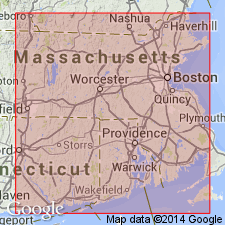
- Usage in publication:
-
- Sachuest Arkose
- Modifications:
-
- Areal extent
- Overview
- Dominant lithology:
-
- Arkose
- Sandstone
- AAPG geologic province:
-
- New England province
Summary:
Author here assigns the Sachuest Arkose, Purgatory Conglomerate, Pondville Conglomerate, Wamsutta Formation, Rhode Island Formation, and Dighton Conglomerate to the Rhode Island Group of northern Rhode Island and southeastern Massachusetts. Basal Pennsylvanian rocks in the southern Narragansett basin now referred to Sachuest Arkose were previously mapped as Pondville Conglomerate by Quinn (1971). Pondville, however, at its type section to the north is quite different lithologically. Sachuest is described as distinctive, pebbly, arkosic, bedded sandstone with intercalations of dark slate. Quartz grains are smoky to almost black. Contains detrital fragments of Cliff Walk Granite. Unit is approximately 30 m thick. [Article states that name was "introduced" by Skehan and others (1986), but according to GNC records the name dates back to Foerste (1899).] Unit is recognized only southeast of the Beaverhead fault zone where it crops out discontinuously from Tiverton.
[Usage of the Rhode Island in this report is not recommended. According to Article 19f of the NACSN code (1983), "In changing the rank of a unit, the same name may not be applied both to the unit as a whole and to a part of it."]
Source: GNU records (USGS DDS-6; Reston GNULEX).
For more information, please contact Nancy Stamm, Geologic Names Committee Secretary.
Asterisk (*) indicates published by U.S. Geological Survey authors.
"No current usage" (†) implies that a name has been abandoned or has fallen into disuse. Former usage and, if known, replacement name given in parentheses ( ).
Slash (/) indicates name conflicts with nomenclatural guidelines (CSN, 1933; ACSN, 1961, 1970; NACSN, 1983, 2005, 2021). May be explained within brackets ([ ]).

